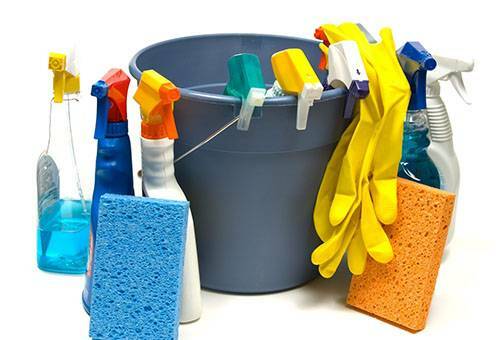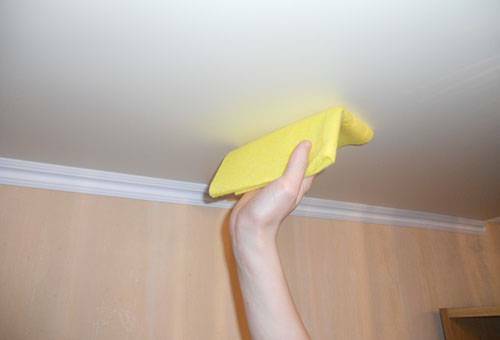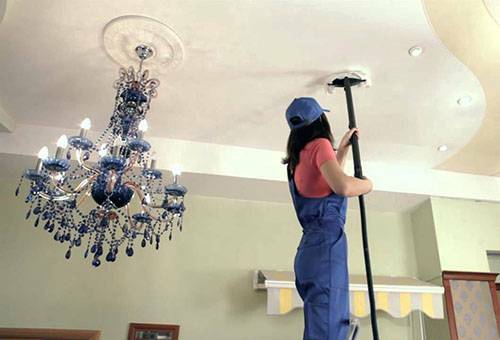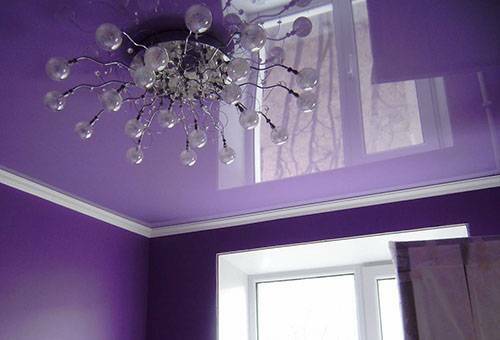Contents:
- Than to wash?
- Precautions
- How to wash?
- Dry cleaning
- Conclusion
Stretch ceilings enjoy a well-deserved popularity in the repair work due to the simplicity and speed of installation, ease of use, the possibility of interesting design solutions. Although care for glossy stretch ceilings, as well as for matte and fabric covers, is minimized, from time to time they still need to be cleaned. Such ceilings are made of dirt-repellent materials, but some amount of dust and contaminants on them still remains. And if this coating is installed in the kitchen, where there is no extract, then there are still small greasy spots and traces of soot.

Than to wash?
To care for the surface, use a soft cloth or foam rubber sponge( as for dishes).Fleecy fabrics leave small and hard-to-remove hairs on it, and hard jaws and brushes can damage the ceiling, break its shiny finish, leave scratches and even tear. Accordingly, you can not use and tools with abrasive additives, even if they are very small.
- You can wash the ceiling with glass cleaners. Among other things, they are very convenient due to the presence of an atomizer. The fact that they contain alcohol should not frighten: for the surface it is absolutely harmless. The main thing that in the composition there was no acetone.
- To wash the ceiling, you can use ordinary washing powder, but it should be stirred very carefully, so that even the smallest particles are dissolved in water. The water temperature should not exceed 40 degrees.
- You can also dilute in a soft dishwashing liquid, shampoo, shower gel or liquid soap. These funds are very good foaming, so many add them there is no need, otherwise it will take a very long time to wash off the soapy water from the ceiling.
- There are also special polish for stretch ceilings, which are guaranteed to clean the dirt and do not harm the surface. Particularly heavily soiled contamination can be removed with ammonia.

Precautions
- Although the fabric of the stretch ceiling is elastic, that is, it stretches, it does not endlessly. If too much pressure on the canvas, there is a risk eventually to break it.
- In case when the suspended ceiling hangs only slightly below the usual, you should wash it carefully so that they do not come in contact.
- It is strongly recommended not to use a mop, because it is difficult to adjust the force of pressing with it, which means it is possible to damage the ceiling.
advice Even seemingly non-aggressive means can cause unpredictable reaction on the material - color change, appearance of wrinkles, etc. Therefore, before washing the entire ceiling, it is better to test on a small area in an inconspicuous place of the room - in a corner, next tohigh furniture, etc. If in 10-15 minutes the applied agent did not affect the surface in any way, it can be safely used. Well, if the installation was a small fragment of the ceiling - then you can check the detergents on it.

How to wash?
Before you wash the ceiling, you should remove all jewelry that could potentially scratch or tear the fabric. Girls with long, pointed nails need to be especially careful.
Due to the mirror gloss on the glossy ceilings, the pollution is much more noticeable than on the matt texture, so it will be necessary to clean such ceilings somewhat more often. And on the shiny surface is clearly visible not only dirt, but also traces of careless washing.
Wipe the ceiling with soft circular motions, trying not to force it too hard not to deform or tear. Do not rub too hard, hoping to polish the surface better. It is better to shine it will not, on the contrary, there is a risk of making it matte.
If a soapy solution is used, it must be thoroughly rinsed. Alcohol funds do not need this. But in the case when after the cleaning on the ceiling there are still stains, they can easily be removed with a dry cloth or a cloth made of microfiber.

Dry Cleaning
For dry cleaning of the ceiling from dust and cobwebs, you can use a dry cloth or a vacuum cleaner. To prevent the vacuum cleaner from damaging the surface, remove the brushhead from it, select the minimum suction power, and if this is not possible, keep it at a certain distance.
There is no need to thoroughly wash the ceiling with each cleaning. It is enough to remove dust and cobwebs every few months and wash the surface every six months or a year.

Conclusion
When the suspended ceiling is only installed, it is worthwhile to ask the installers about the most suitable means for it. These people have great practical experience and will give really useful advice. Independently to find recommendations on how to care for the ceiling, you can in the instructions to him or on the website of the manufacturer.
All the recommendations for the care of the ceiling can be reduced to the following - it should be washed carefully and do not use the means or objects that can tear or scratch the canvas.
